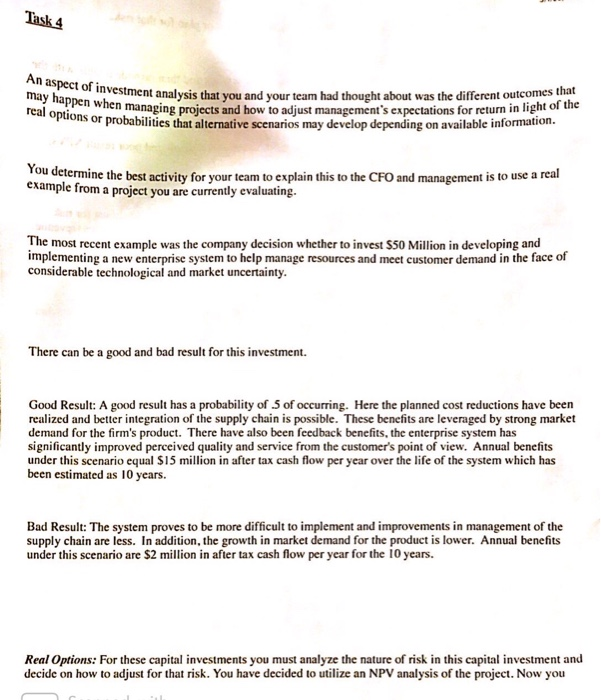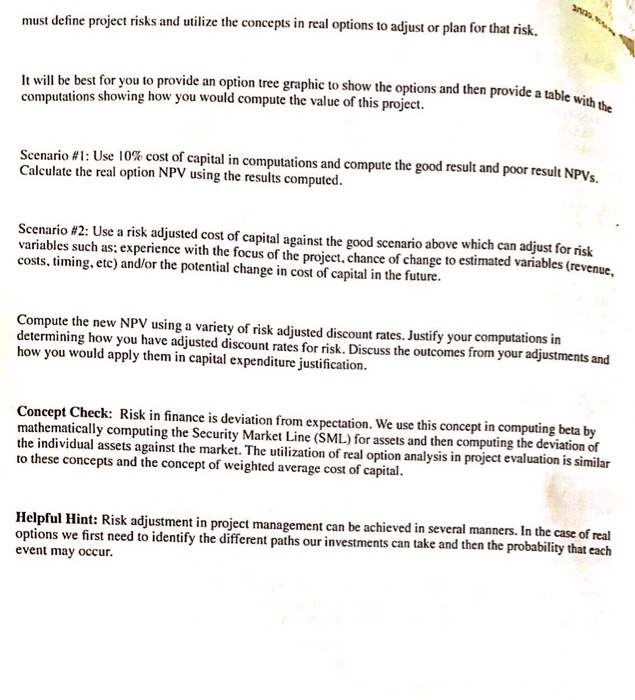Task 4 An aspect of investment analys may happen when managing pro real options or probabiliti vestment analysis that you and your team had thought about was the different outcomes that when managing projects and how to adiust management's expectations for return in light on wis or probabilities that alternative scenarios may develop depending on available information. You determine the bc uetermine the best activity for your team to explain this to the CFO and management is to use a real example from a project you are currently evaluating. The most recent example was the company decision whether to invest $50 Million in developing and implementing a new enterprise system to help manage resources and meet customer demand in the face of considerable technological and market uncertainty. There can be a good and bad result for this investment. Good Result: A good result has a probability of 5 of occurring. Here the planned cost reductions have been realized and better integration of the supply chain is possible. These benefits are leveraged by strong market demand for the firm's product. There have also been feedback benefits, the enterprise system has significantly improved perceived quality and service from the customer's point of view. Annual benefits under this scenario equal $15 million in after tax cash flow per year over the life of the system which has been estimated as 10 years. Bad Result: The system proves to be more difficult to implement and improvements in management of the supply chain are less. In addition, the growth in market demand for the product is lower. Annual benefits under this scenario are $2 million in after tax cash flow per year for the 10 years. Real Options: For these capital investments you must analyze the nature of risk in this capital investment and decide on how to adjust for that risk. You have decided to utilize an NPV analysis of the project. Now you must define project risks and utilize the concepts in real options to adjust or plan for that risk. It will be best for you to provide an option tree graphic to show the options and then provide a table computations showing how you would compute the value of this project. de a table with the Scenario #1: Use 10% cost of capital in computations and compute the good result and poor result NPV. Calculate the real option NPV using the results computed. Scenario #2: Use a risk adjusted cost of capital against the good scenario above which can adjust for risk variables such as; experience with the focus of the project, chance of change to estimated variables (revenue. costs, timing, etc) and/or the potential change in cost of capital in the future. Compute the new NPV using a variety of risk adjusted discount rates. Justify your computations in determining how you have adjusted discount rates for risk. Discuss the outcomes from your adjustments and how you would apply them in capital expenditure justification. Concept Check: Risk in finance is deviation from expectation. We use this concept in computing beta by mathematically computing the Security Market Line (SML) for assets and then computing the deviation of the individual assets against the market. The utilization of real option analysis in project evaluation is similar to these concepts and the concept of weighted average cost of capital. Helpful Hint: Risk adjustment in project management can be achieved in several manners. In the case of real options we first need to identify the different paths our investments can take and then the probability that each event may occur. Task 4 An aspect of investment analys may happen when managing pro real options or probabiliti vestment analysis that you and your team had thought about was the different outcomes that when managing projects and how to adiust management's expectations for return in light on wis or probabilities that alternative scenarios may develop depending on available information. You determine the bc uetermine the best activity for your team to explain this to the CFO and management is to use a real example from a project you are currently evaluating. The most recent example was the company decision whether to invest $50 Million in developing and implementing a new enterprise system to help manage resources and meet customer demand in the face of considerable technological and market uncertainty. There can be a good and bad result for this investment. Good Result: A good result has a probability of 5 of occurring. Here the planned cost reductions have been realized and better integration of the supply chain is possible. These benefits are leveraged by strong market demand for the firm's product. There have also been feedback benefits, the enterprise system has significantly improved perceived quality and service from the customer's point of view. Annual benefits under this scenario equal $15 million in after tax cash flow per year over the life of the system which has been estimated as 10 years. Bad Result: The system proves to be more difficult to implement and improvements in management of the supply chain are less. In addition, the growth in market demand for the product is lower. Annual benefits under this scenario are $2 million in after tax cash flow per year for the 10 years. Real Options: For these capital investments you must analyze the nature of risk in this capital investment and decide on how to adjust for that risk. You have decided to utilize an NPV analysis of the project. Now you must define project risks and utilize the concepts in real options to adjust or plan for that risk. It will be best for you to provide an option tree graphic to show the options and then provide a table computations showing how you would compute the value of this project. de a table with the Scenario #1: Use 10% cost of capital in computations and compute the good result and poor result NPV. Calculate the real option NPV using the results computed. Scenario #2: Use a risk adjusted cost of capital against the good scenario above which can adjust for risk variables such as; experience with the focus of the project, chance of change to estimated variables (revenue. costs, timing, etc) and/or the potential change in cost of capital in the future. Compute the new NPV using a variety of risk adjusted discount rates. Justify your computations in determining how you have adjusted discount rates for risk. Discuss the outcomes from your adjustments and how you would apply them in capital expenditure justification. Concept Check: Risk in finance is deviation from expectation. We use this concept in computing beta by mathematically computing the Security Market Line (SML) for assets and then computing the deviation of the individual assets against the market. The utilization of real option analysis in project evaluation is similar to these concepts and the concept of weighted average cost of capital. Helpful Hint: Risk adjustment in project management can be achieved in several manners. In the case of real options we first need to identify the different paths our investments can take and then the probability that each event may occur








